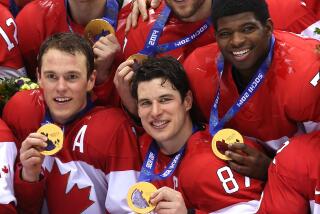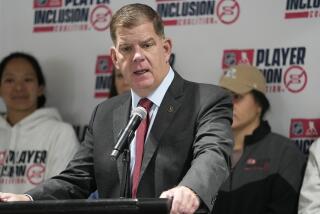New Game for the NHL
- Share via
NEW YORK — It was a foregone conclusion that the NHL would ratify the collective bargaining agreement players had grudgingly swallowed, and the 30 governors lined up Friday to welcome more cost controls than they’d dreamed of when Commissioner Gary Bettman locked players out last Sept. 15.
But with uncharacteristic boldness, the governors also took steps to energize a game that had withered long before labor woes dragged it out of sight and mind.
On the first day of the rest of the NHL’s life, Bettman ended the 310-day lockout and reopened the league for business today. He also announced an array of rule changes that are intended to promote scoring and bring back the speed and skill that had too often been blunted by defensive tactics.
“I know the league’s future is bright, and this will be to the benefit of the game,” Bettman said at a news conference. “We had no choice but to get it right.”
The six-year deal with the players’ association provides the right footing, he said, because clubs will become partners with one another through revenue sharing and players will have incentive to help the league and promote the game because payrolls will be tied to revenues.
The “long, dark days of the lockout” having ended, he said, “Let’s drop the puck on a fresh start for the NHL.”
It will start up again today with a six-day period in which clubs can buy out existing contracts, and heat up on Aug. 1, when signing restricted and unrestricted free agents is permitted. Games begin Oct. 5.
The deal, which had been ratified by players Thursday, caps payrolls at $39 million in the 2005-06 season including salaries, signing bonuses and performance bonuses, and sets a floor of $21.5 million. Players will be guaranteed 54% of league revenues in any year that revenues are below $2.2 billion, 55% when revenues are between $2.2 billion and $2.4 billion, 56% when revenues are $2.4 to $2.7 billion, and 57% when revenues in any year exceed $2.7 billion. The NHL and the union agreed to estimate league revenues at $1.7 billion next season, which might be generous.
Existing contracts will be cut by 24%, and no player will get more than 20% of the league cap figure in total compensation; for next season, that’s no more than $7.8 million in any year of his contract. Entry-level salaries will be capped at $850,000 for 2005 and 2006 draftees and will reach $925,000 for players drafted in 2011. The minimum salary was boosted from $185,000 to $450,000 next season and will hit $500,000 in the last two seasons of the agreement. To end holdouts, restricted free agents who aren’t signed by Dec. 1 of a given year cannot play that season.
“We’ve been fighting for this, waiting for this, planning for this,” King President Tim Leiweke said. “This is a great day for the NHL and a great day for fans, because no one buys the Cup anymore.”
Darcy Regier, general manager of the Buffalo Sabres, embraced the changes. “More than anything else, it gives hope in marketplaces like ours,” he said.
Jim Rutherford, general manager of the money-losing Carolina Hurricanes, said the deal had “enough safety nets to protect teams from getting into positions they were in. We believe in our market and that it will grow as we grow our franchise.
“The best marketing is exciting games and winning, and as long as the league sticks to the obstruction rules, that’s going to create more chances.”
The promised crackdown on obstruction involves a philosophical change, not an amendment of rules. The approved changes include a shootout to settle regular-season games that are tied after 60 minutes and five minutes of overtime, elimination of the red line in regard to two-line passes, moving the nets two feet closer to the end boards and reducing the size of goaltenders’ equipment.
King General Manager Dave Taylor said there was “some discussion” especially surrounding the shootout. In addition, a proposal to expand the playoffs from 16 teams to 20 did not come to pass.
Taylor said he initially opposed allowing two-line passes, “but as part of the overall package we can certainly live with it. There will be more room in the offensive zone, more long bombs and breakaways.”
At least in theory. The NHL has previously promised to punish obstruction and backed off as the season progressed, but it can’t afford to repeat that mistake.
“In talking to fans, what we consistently heard is, ‘We want a better product on the ice,’ ” said Red Wing forward Brendan Shanahan, who helped shape the changes as a member of the NHL’s competition committee.
“There’s been a recognition that the fans want more. There’s a commitment from players.”
Said Colin Campbell, the NHL’s director of hockey operations: “We’re all on the same platform now. We’re all going to have ownership of this mandate.”
Bettman vowed the league would make a fervent commitment to its fans and would use technology to provide greater access to players during TV broadcasts. “It’s time for our fans to have some fun again, and it’s our objective to give them all they can handle,” said Bettman, who also announced the promotion of Bill Daly from senior vice president to deputy commissioner.
“We will return to rebuild, renew, refresh and reinvigorate our game and our league on a number of levels. We will do everything, everything to be the best we can be and to earn your continued devotion. We know this was a terrible time for everyone associated with the game. We will do everything we can to make it up to you.”
Many teams have cut ticket prices to lure back fans, but the lockout’s full impact won’t be known for a while. Nor is it easy to declare a winner in the labor dispute that cost the league the 2004-05 season, even though the new agreement appears slanted toward owners. The same assessment was made about the last agreement, until agents and players found ways to drive salaries up faster than the league generated revenues.
“The CBA ratified by the players [on Thursday] is being portrayed as a surrender and capitulation on behalf of the NHLPA membership,” said Allan Walsh, an agent based in Los Angeles. “I would caution everyone that it is not necessarily who wins the war, but the real question going forward is which side will best manage the peace.”
*
(BEGIN TEXT OF INFOBOX)
NHL accords
Highlights of the NHL’s collective bargaining agreement, announced Friday by Commissioner Gary Bettman after having been ratified by the players on Thursday, which ended a 310-day lockout:
* New look
The NHL will return with a new silver-and-white shield logo, new rules, and a schedule that will emphasize division and conference rivalries.
* Scheduling
Each club will play eight games against division rivals (32 total) and four games against each of the 10 non-division clubs in its conference (40). Each club will also play 10 inter-conference games, playing host to one game each against five clubs from a designated division and traveling for one game against each of the five clubs in a different division.
*
This season, the Kings and Ducks will travel to play Northeast division clubs (Boston, Buffalo, Montreal, Ottawa and Toronto) and will play host to Southeast division clubs (Atlanta, Carolina, Florida, Tampa Bay and Washington).
* Playing off a tie
Shootouts will decide regular-season games that are tied after 60 minutes and a five-minute overtime. Three players from each team will participate, as selected by the coach. If the teams are tied after six shots, the shootout will take a sudden-death format. The final score will give the winning team one more goal than its opponent, regardless of the number of goals scored during the shootout. Goals or saves in the shootout don’t count in players’ individual totals.
* The rink
The goal lines will be 11 feet from the end boards, two feet closer than before. The neutral zone will be reduced to 50 feet from 54 feet.
* Equipment
Goaltenders’ leg pads will be reduced in width by one inch, to 11 inches. The blocking glove, upper-body protector, pants and jersey will also be reduced in size.
* Calling the game
Goaltenders will be allowed to play the puck behind the goal line only in a trapezoid-shape area that will be outlined on the ice. If they play the puck outside that area they will be penalized for delay of game.
*
Officials will show “zero tolerance” toward interference, hooking and holding obstruction.
*
The tag-up rule will allow play to continue if an offensive player who preceded the puck into the zone returns to the blue line and “tags” it.
* Olympic representation
The NHL will allow players to represent their homelands at the 2006 Turin Olympics and the 2010 Vancouver Olympics, pending negotiation of an agreement with the International Ice Hockey Federation.
* Drug testing
NHL players will be subject to two random, no-advance notice tests for performance-enhancing drugs each year. A first positive test will bring a 20-game suspension without pay, a second positive will result in a 60-game suspension and a third positive will be a minimum two-year suspension after which the player would have to apply for reinstatement.
--
Key points
With the collective bargaining agreement ratified, Commissioner Gary Bettman officially ended the 310-day lockout. A look at the some of Friday’s developments:
* The 2005-06 NHL season will open Oct. 5, with all 30 teams scheduled to play. The Kings will open at Dallas and the Mighty Ducks will open at Chicago.
* Friday’s draft lottery gave the Pittsburgh Penguins the first pick in the July 30 entry draft and the right to choose Sidney Crosby, the Canadian phenom.
More to Read
Go beyond the scoreboard
Get the latest on L.A.'s teams in the daily Sports Report newsletter.
You may occasionally receive promotional content from the Los Angeles Times.







